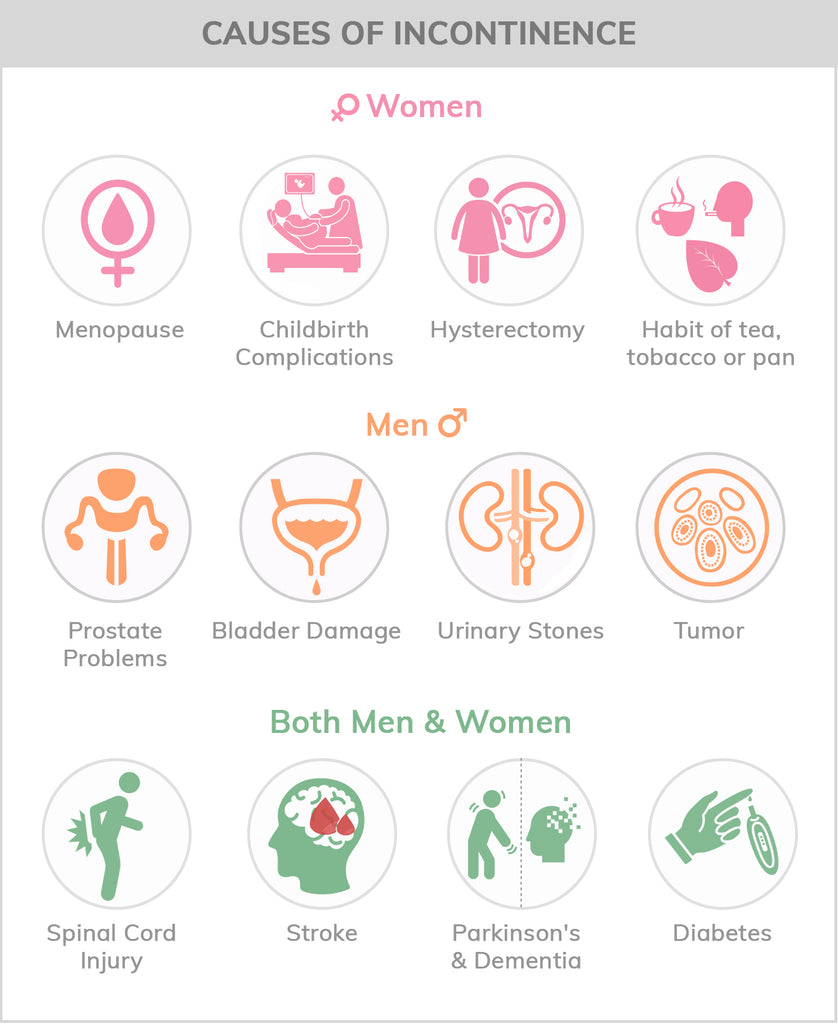Your Shopping Bag is Empty

Though often under reported to medical practitioners, urinary incontinence is a very common problem encountered by senior citizens, with at least 35% of them reporting it globally. In India, approximately 2.4 crores (24 million) people are affected, most of them above 45 years old. Patients often find it embarrassing to describe and express and that's why it goes unreported. However, it can be indicative of a more serious problem, and hence, should be reported to a doctor. If you are experiencing incontinence, the following information will help you better understand why it’s happening and how you can manage it.
Based on the underlying problem, it may be:
Many people, especially elderly women, also experience mixed incontinence, which is a combination of stress and urge incontinence. A patient may also have double incontinence, where they soil themselves while urinating.
Survey reports reveal in India, stress incontinence is most common in females and urge incontinence is more common in males. Research shows that around 21.8% of Indian women above 40 years of age suffer from urinary incontinence. Among them a majority of women (73.8%) were found to have stress incontinence, followed by mixed (16.5%) and urge incontinence (9.5%).
Incontinence in seniors has a significant correlation with age, sex, social status, depression and number and type of drugs. Women often experience mixed incontinence. After going through menopause, they have significantly lower levels of estrogen in their blood. This may cause weakening and thinning of the urethra (the tube that urine passes from the bladder).
If during childbirth, any of the supporting structures of the urethra, abdominal or pelvic floor muscles were damaged (for example: in cases of vaginal delivery with forceps, multiple births, multi-parity, etc.), stress incontinence is often a consequence. Hysterectomy (surgical removal of uterus), asthma, habit of tea, tobacco, pan and betel intake have been found to be some of the risk factors
Elderly men commonly have prostate enlargement or other prostate problems. This can lead to overflow incontinence. Damage to the bladder and blockage of the urethra by stones or a tumor are also contributing factors.
In both men and women, neurological conditions such as birth defects, strokes, spinal cord injury, Parkinson’s, and inflammation of the bladder (known as cystitis) may cause urge incontinence.
Diabetes increases the amount of urine produced, and hence may aggravate the urgency and frequency of urination. Dementia, poor eyesight, poor mobility, poor dexterity (inability to unbutton pants in time) and confusion are commonly associated with functional incontinence.

LOOKING FOR ANTI-INCONTINENCE PRODUCTS? Click here
The first step is to visit a doctor to diagnose what the cause of the incontinence is. They may, among other things, take blood and urine samples, do a physical exam and ask you to keep a log of when and how often you are incontinent. Based on that, they will advise a treatment plan.
Depending on the cause and severity, you may be asked to use the bathroom at fixed intervals everyday, train your bladder to control the urge, or be taught Kegel, or pelvic floor muscle, exercise.
You may also be prescribed medication, or be asked to use certain devices such as collecting bags, diapers or pessaries (a rigid vaginal insert which supports the urethra from inside), based on your case and ease of use. According to recent survey, use of diapers and under-pads are becoming more popular among Indian elderly adults with over 90% accepting its use.
Developing better dietary habits like avoiding caffeine, alcohol and acidic drinks can help manage urinary incontinence better. Chocolates, artificial sweeteners and hot spices often irritate the bladder, so, they are best to be excluded from the patient’s diet. Elderly adults with obesity problems might consider weight reduction activities, in consultation with their doctor and physiotherapist, as often excess weight puts unnecessary pressure on the bladder.
To know more about managing urinary incontinence, Read our blog
To learn how to use an adult diapers, Read here
By Dharini Prasad
Guest Author and Student of Medicine
Bibliography
Urinary Incontinence, Medical News Today | Urinary Incontinence, MAYO CLINIC | Urinary Incontinence, NHS Choices | Practice Essentials, Medscape | Prevalence and risk factors of urinary incontinence in Indian women: A hospital-based survey, NCBI | Urinary Incontinence among older Indians: Assessment and impact on Quality of Life, Oxford Academic
Comments will be approved before showing up.